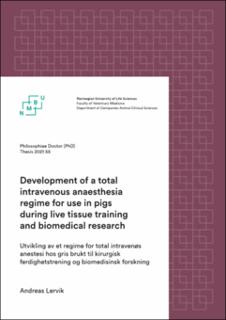| dc.contributor.advisor | Haga, Henning Andreas | |
| dc.contributor.advisor | Ranheim, Birgit | |
| dc.contributor.author | Lervik, Andreas | |
| dc.date.accessioned | 2023-03-02T09:24:46Z | |
| dc.date.available | 2023-03-02T09:24:46Z | |
| dc.date.issued | 2021 | |
| dc.identifier.isbn | 978-82-575-1827-1 | |
| dc.identifier.issn | 1894-6402 | |
| dc.identifier.uri | https://hdl.handle.net/11250/3055214 | |
| dc.description.abstract | Large animal models are commonly used in biomedical research or for medical training purposes where cardiovascular instability is encountered. Pigs are frequently used as their cardiorespiratory anatomy and physiology are thought to resemble that of humans closely. General anaesthesia is mostly a legal requirement when using pigs for this purpose. There is however a paucity in the scientific literature when it comes to research on anaesthesia in pigs, with anaesthetic techniques often being extrapolated from those used in other species, including human anaesthesia.
The overall aim of this work was to develop an anaesthetic regime that can be applied when anaesthetising pigs for live tissue training and biomedical research where surgically induced nociception or cardiovascular instability can be encountered.
An experiment was conducted comparing total intravenous anaesthetic protocols with either propofol-ketamine-fentanyl or propofol-ketamine-dexmedetomidine. We concluded that both anaesthetic regimes provided stable cardiovascular conditions in normovolemic pigs. Additionally, solid antinociception was provided, in particular when including dexmedetomidine in the anaesthetic protocol.
This experiment led to new research questions, and further experiments were conducted to examine the cardiovascular function during hypovolemia due to blood loss and the respiratory function during total intravenous anaesthesia with either propofol-ketamine-dexmedetomidine or alfaxolone-ketamine-dexmedetomidine. In addition, the difference in nociceptive response to different modalities of nociceptive stimulation between pigs given fentanyl or dexmedetomidine that was observed during the first experiment was examined further.
The major findings of this experimental work are that total intravenous anaesthesia with either propofol-ketamine-dexmedetomdine or alfaxalone-ketamine dexmedetomdine are suitable anaesthetic regimes in pigs when cardiovascular instability is foreseen during live tissue training or biomedical research, and that these pigs tolerate a substantial blood loss. When using these anaesthetic regimes respiratory supportive measures must be taken. Oxygen supplementation and the ability to provide positive pressure ventilation must be available. Plasma concentrations of both propofol and alfaxalone may increase during moderate to severe blood loss, and dose adjustments can be necessary. Both dexmedetomidine and fentanyl seem to provide solid antinociception in pigs when given as a constant rate infusion. In our study population of juvenile pigs, dexmedetomidine did not negatively influence cardiovascular function to the extent that has been observed in other species. | en_US |
| dc.description.abstract | Når store forsøksdyr brukes i biomedisinsk forskning eller ved medisinsk ferdighetstrening kan kardiovaskulær instabilitet oppstå. Gris blir ofte brukt som modelldyr, ettersom det er en oppfatning av at artens kardiorespiratoriske anatomi og fysiologi likner menneskets. Generell anestesi av gris til dette formålet er relativt vanlig, men publisert forskning på effektene av ulike anestesiregimer til gris er mangelfull. Ofte ekstrapoleres anestesiteknikker fra andre arter, blant annet fra human anestesiologi.
Hovedformålet med dette vitenskapelig arbeidet var å utvikle et anestesiregime til bruk på gris som anesteseres for medisinsk ferdighetstrening og biomedisinsk forskning der kirurgisk indusert nosisepsjon og kardiovaskulær instabilitet kan oppstå.
I det første eksperimentet ble effektene av total intravenøs anestesi med propofol-ketamin-fentanyl og propofol-ketamin-deksmedetomidin sammenlignet. Hovedfunnet var at begge anestesiregimer gav stabil kardiovaskulær status og solid antinosisepsjon.
Eksperimentet ga opphav til nye forskningsspørsmål. Videre eksperiment ble gjennomført for å undersøke kardiovaskulær funksjon ved hypovolemi og respiratorisk funksjon hos griser anestesert med enten propofol-ketamin-deksmedetomidin eller alfaxalon-ketamin-deksmedetomidin. I tillegg undersøkte vi den forskjellige nosiseptive responsen vi observerte ved ulike modaliteter for nosiseptiv stimulering hos griser som fikk enten fentanyl eller deksmedetomidin i det første eksperimentet.
De viktigste funnene i våre undersøkelser er at total intravenøs anestesi med enten propofol-ketamin-deksmedetomdin eller alfaxalon-ketamin-deksmedetomidin kan brukes til generell anestesi av gris ved medisinsk ferdighetstrening eller biomedisinsk forskning når kardiovaskulær instabilitet forventes, og at disse grisene tolererer et relativt stort blodtap. Når man bruker disse anestesiregimene må respiratorisk støttebehandling være tilgjengelig, og muligheter til å gi tilskudd av oksygen og overtrykksventilering må være til stede. Plasmakonsentrasjoner av både propofol og alfaxalon kan øke ved moderat til kraftig blodtap, og dosejusteringer kan være nødvendig. Både fentanyl og deksmedetomidin gitt som en kontinuerlig infusjon ser ut til å gi solid antinosisepsjon hos gris. I vår studiepopulasjon bestående av juvenile griser så ikke deksmedetomidin ut til å påvirke kardiovaskulær funksjon like negativt hos gris som hos andre arter. | en_US |
| dc.description.sponsorship | Animal Health and Welfare Branch, Veterinary Inspectorate, and Force Health Protection, Norwegian Armed Forces Joint Medical Services | en_US |
| dc.language.iso | eng | en_US |
| dc.publisher | Norwegian University of Life Sciences, Ås | en_US |
| dc.relation.ispartofseries | PhD Thesis;2021:55 | |
| dc.rights | Attribution-NonCommercial-NoDerivatives 4.0 Internasjonal | * |
| dc.rights.uri | http://creativecommons.org/licenses/by-nc-nd/4.0/deed.no | * |
| dc.subject | Anaesthesia | en_US |
| dc.subject | TIVA | en_US |
| dc.subject | Pigs | en_US |
| dc.subject | Experimental animals | en_US |
| dc.title | Development of a total intravenous anaesthesia regime for use in pigs during live tissue training and biomedical research | en_US |
| dc.title.alternative | Utvikling av et regime for total intravenøs anestesi hos gris brukt til kirurgisk ferdighetstrening og biomedisinsk forskning | en_US |
| dc.type | Doctoral thesis | en_US |

